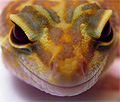» Site Navigation

1 members and 562 guests
Most users ever online was 47,180, 07-16-2025 at 05:30 PM.
» Today's Birthdays

» Stats

Members: 75,912
Threads: 249,117
Posts: 2,572,190
Top Poster: JLC (31,651)
Welcome to our newest member, coda
|
-
BPnet Veteran


Re: Bumble Bee X double het caramel glow?
 Originally Posted by GenePirate

Bee is on the top, het caramel glow on the bottom. You can set up your square like this:
.........PScg Pscg pScg pscg
psCg
pscg
psCG
pscG
However, don't make things more complicated than they are. The bee has NO chance of throwing a caramel or ghost gene, so take those out of the mix. Similarly, the double het CG has NO chance of contributing a pastel or spider gene, so take those out of the mix. Only consider what your breeders can contribute, then assume the rest. You will wind up with this:
......PS Ps pS ps
Cg
cg
CG
cG
So, you can get equal chances of a bee het for caramel, pastel het for caramel, spider het for caramel, het caramel, bee, pastel, spider, normal, double het CG bee, double het CG pastel, double het CG spider, double het CG, bee het for ghost, pastel het for ghost, spider het for ghost, or het ghost. Each possibility is 1 in 16.
But, you'll have no idea which are going to be the CG single or double hets. Good luck.
 Originally Posted by Kevin_Hornby

I actually find it makes more sense to me if I list all the genes that are involved on both sides.
I agree with Kevin. If you fill out the punnett square:
.........PScg Pscg pScg pscg
psCg
pscg
psCG
pscG
each outcome will show BOTH allels for each gene. If you write it this way:
......PS Ps pS ps
Cg
cg
CG
cG
you only have a single allel for each gene, which isn't an effective way of figuring it out. You won't necessarily know the genotype or phenotype of a given outcome from a cross if you aren't showing both allels. The other way of writing out the punnett square (above) seems much more consistent and relevant.
Another way of thinking about it is to just use what you know. A double het Caramel Glow x normal (since there are no caramel or hypo genes from the other parent) will yield Normals, Het Hypos, Het Caramels, and Double Het Caramel Glow. Since they will all appear normal, they will all be labled as 50% Possible Double Het for Hypo and Caramel (Caramel Glow). A Bee x normal paring will statistically yield 25% Bees, 25% Spiders, 25% Pastels, and 25% Normals. So with a Bee x DH Caramel Glow clutch, just combine the odds. Statistically, you'll get 25% Bees, 25% Spiders, 25% Pastels, and 25% Normals, all of which will be 50% Possible Double Het for Hypo and Caramel (Caramel Glow). Since you can tell the difference between Bees, Spiders, Pastels, and Normals, you'll know what you have when you hatch them out.
Bees 50% Possible Double Het for Hypo and Caramel (Caramel Glow)
Spiders 50% Possible Double Het for Hypo and Caramel (Caramel Glow)
Pastels 50% Possible Double Het for Hypo and Caramel (Caramel Glow)
Normals 50% Possible Double Het for Hypo and Caramel (Caramel Glow)
Just my way of looking at it.
-
 Posting Permissions
Posting Permissions
- You may not post new threads
- You may not post replies
- You may not post attachments
- You may not edit your posts
-
Forum Rules
|











 Reply With Quote
Reply With Quote